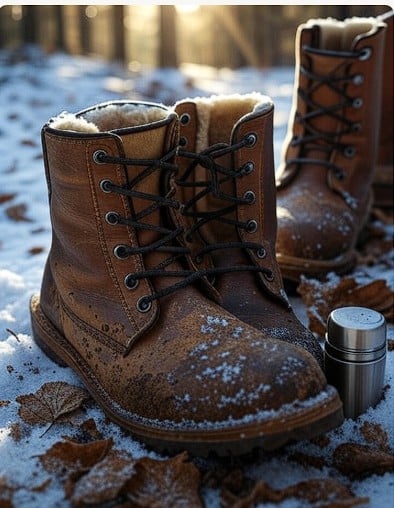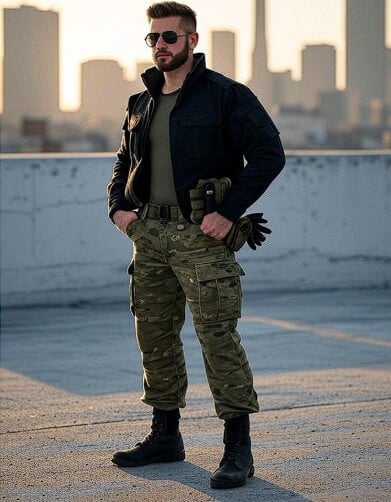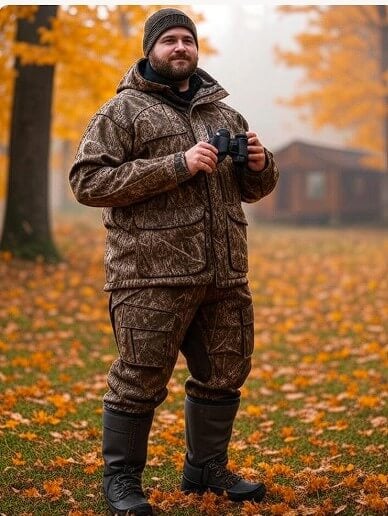Hey there! Today, we’re going to talk about something super interesting from history: tarnkleidung Wehrmacht, which is a fancy way of saying the camouflage clothes used by the German army during World War II. Camouflage is like a special outfit that helps soldiers hide in nature, like forests or fields. Let's get into what tarnkleidung Wehrmacht was, why it mattered, and how it functioned. This is going to be an exciting trip back in time, so let's begin!
What is Tarnkleidung Wehrmacht?
The term tarnkleidung Wehrmacht may seem confusing, but it's really not! "Tarnkleidung" is German for "camouflage clothing," and "Wehrmacht" is what they called the German army between 1935 and 1945. So, tarnkleidung Wehrmacht is just the camouflage uniforms soldiers wore to match their environment. These uniforms featured designs such as spots, stripes, or shapes resembling leaves or trees. This allowed soldiers to remain invisible to the enemy.
Camouflage is a big deal in wars because it makes it harder for the other side to spot you. Imagine playing hide-and-seek in the woods. If you’re wearing bright red, you’re easy to find. But if your clothes look like the trees or grass, you’re super hard to spot! That’s exactly what tarnkleidung Wehrmacht did for German soldiers.
Why Did the Wehrmacht Use Camouflage?
During World War II, there were fights in every type of environment—woods, deserts, cold mountains, and even urban areas. The Wehrmacht, or German army, required clothing that would keep their men safe by camouflaging them. That is where tarnkleidung Wehrmacht was used. It was designed to camouflage the environment where men were fighting. For instance, if they were in a forest, they had brown and green colors on their clothes to resemble trees. If they were among snow, they wore white color to blend with the snow.
The Wehrmacht began implementing camouflage because they could see how effective it was. Other militaries, such as the British or Americans, employed camouflage as well, but the Germans created some really awesome designs. The Wehrmacht tarnkleidung wasn't merely for appearing awesome, however—it was for saving soldiers' lives by making them less visible.
The History of Tarnkleidung Wehrmacht
The history of tarnkleidung Wehrmacht began in the 1930s. Soldiers used to wear plain uniforms, such as gray or green ones, that didn't camouflage very well. But in World War I, it was observed that colorful uniforms made soldiers stand out and become easy targets. When World War II arrived, the Germans thought that they needed to be clever with their uniforms.
In 1937, the Wehrmacht tested out camouflage patterns. They needed something that would be used in various locations, such as forests or fields. In 1940, they had some fantastic designs, such as the "splittertarn" pattern, which contained jagged lines that resembled shattered glass. This was one of the first forms of tarnkleidung Wehrmacht. It was used extensively because it performed very well in Europe's forests and fields.
The Germans created even more patterns as the war continued. They were named "eichenlaubmuster" (meaning "oak leaf pattern") and "erbsentarn" (meaning "pea dot pattern"). These names are silly, but they were really serious about concealing soldiers. Each pattern was designed for a particular location, such as summer forests or autumn fields.
Types of Tarnkleidung Wehrmacht Patterns
The Wehrmacht tarnkleidung came in a multitude of designs, and each was unique. There are a few of the most well-known ones listed below:
Splittertarn: The Classic Camouflage
The "splittertarn" pattern was one of the original types of Wehrmacht tarnkleidung. It featured jagged, pointed shapes in green, brown, and tan. It resembled shattered glass or wood splinters, hence the name "splittertarn" (splinter pattern). It was perfect for camouflage in woodlands or grasslands. Troops wore it on jackets, trousers, and even helmet covers.
Eichenlaubmuster: The Oak Leaf Look
There was also another hip design called "eichenlaubmuster," or "oak leaf pattern." This design featured leaves resembling oak leaves. It existed in two forms: the spring and summer version (with a lot of green) and the autumn version (with brown and orange tones). This kind of Wehrmacht tarnkleidung was really popular with top troops, such as the SS, who engaged in brutal fighting.
Erbsentarn: The Pea Dot Design
The "erbsentarn" or "pea dot" pattern was among the last Wehrmacht used. It contained small dots and spots in green, brown, and yellow. It resembled sort of a bunch of peas randomly placed on the clothing! This pattern was great because it existed in lots of places, such as forests, fields, or even boulders. The tarnkleidung Wehrmacht with this pattern was utilized extensively toward the latter part of the war.
Other Patterns
There were also other kinds of tarnkleidung Wehrmacht, such as the "sumpftarn" (swamp pattern) for marshy and wet environments, and simple white uniforms for snowy environments. The Germans were very skilled at creating camouflage for all types of environments. They even created camouflage covers for tanks and vehicles so they could camouflage those too!
How Was Tarnkleidung Wehrmacht Made
Producing tarnkleidung Wehrmacht was a large undertaking. To begin with, designers had to determine what colors and forms would be most effective at camouflaging. They researched nature, such as the appearance of leaves and branches, in order to create patterns that would blend in. They then imprinted these patterns onto clothing through the use of specialized machines.
The Wehrmacht uniforms were constructed with durable materials such as cotton or a combination of cotton and other materials. They were resilient in order for soldiers to use them in unforgiving areas, such as muddy fields or brier bushes. The Wehrmacht tarnkleidung wasn't only aesthetically pleasing—it needed to survive brutal fighting.
Some uniforms were reversible, meaning that troops could turn them inside out to have a different camouflage look. For instance, a side might be summer green and the other side winter white. This was very intelligent because it meant that troops could use one uniform for several seasons.
Who Wore Tarnkleidung Wehrmacht?
Not all soldiers in the Wehrmacht were able to wear tarnkleidung Wehrmacht. Initially, it was primarily issued to special units, such as the SS or paratroopers, who undertook risky operations. Such soldiers had to remain concealed, and camouflage was extremely vital for them. Further down the war, more ordinary soldiers began wearing it as well, particularly as fights became increasingly difficult.
The Wehrmacht tarnkleidung wasn't exclusive to combat soldiers. Snipers, who needed to remain super still and concealed, adored camouflage because it allowed them to remain unseen. Camouflage uniforms were even worn by tank crews and pilots occasionally when they were down on the ground.
Why Was Tarnkleidung Wehrmacht So Important?
The tarnkleidung Wehrmacht was a big deal because it gave soldiers an advantage. If you’re hard to see, you’re harder to hit. This meant soldiers could move around without being spotted by enemies. It also helped them surprise the other side, which was super important in battles.
Camouflage wasn't all about concealment, however. It also made soldiers stand taller. When you know you're more difficult to see, you may feel bolder sneaking into a forest or field. The tarnkleidung Wehrmacht enabled the German army to fight smarter, not harder.
How Did Other Armies Compare?
The Germans were not alone in using camouflage. Other forces, such as the British, Americans, and Russians, also had their own versions. But the Wehrmacht tarnkleidung was unique because it contained so many various patterns for various locations. The Germans were excellent at producing camouflage that could be used under all weather and terrain conditions.
For instance, the British had a camouflage known as "denison smock," which was perfect for paratroopers. The Americans also employed a pattern referred to as "frogskin," which resembled somewhat the German tarnkleidung Wehrmacht. However, most individuals believe the Germans also had some of the finest designs because they worked so diligently on them.
Tarnkleidung Wehrmacht Today
Although World War II was a long time ago, tarnkleidung Wehrmacht is still really fascinating to humans today. Some people have collections of the old uniforms because they are a large part of history. Museums also have exhibits of tarnkleidung Wehrmacht to reflect on how genius the designs were. Some people who enjoy reenacting World War II fights even wear replicas of these uniforms in order to make everything seem real.
Today's armies continue to utilize camouflage, and some of their patterns have been derived from the tarnkleidung Wehrmacht. For instance, today's German army employs a pattern referred to as "flecktarn," which appears somewhat similar to the vintage pea dot pattern. It is nice to observe how the ideas of the past continue to assist soldiers nowadays!
Interesting Facts Regarding Tarnkleidung Wehrmacht
The following are interesting facts regarding tarnkleidung Wehrmacht:
The Germans were among the very first armies to apply camouflage on a large scale.
Some of the tarnkleidung Wehrmacht uniforms were so effective that foreign countries borrowed them after World War II.
Troops occasionally painted helmets with mud or leaves so that they were even more difficult to spot.
The oak leaf camouflage was such a favorite that it's still incorporated into some camouflage patterns used today.
Creating camouflage was a war secret, and the designers went to great lengths to prevent their patterns from reaching enemies.
Why Do People Care About Tarnkleidung Wehrmacht
You may be asking yourself why individuals continue to speak of tarnkleidung Wehrmacht today. It's because the uniforms say something about how intelligent individuals were in times of adversity. They demonstrate how the Germans applied science and art to keep soldiers safe. In addition, they are just extremely cool to behold! The patterns are puzzle pieces that integrate themselves into nature.
If you’re into history, military stuff, or even just cool designs, tarnkleidung Wehrmacht is something you’d love learning about. It’s like a mix of fashion, science, and adventure all in one!
Conclusion
The tarnkleidung Wehrmacht was a really crucial aspect of World War II. It assisted German soldiers in camouflaging, being safe, and fighting more effectively. With stunning designs such as splittertarn, eichenlaubmuster, and erbsentarn, these uniforms were magic cloaks that made soldiers almost invisible in forests, fields, and snow. Even today, people are amazed by these patterns because they indicate how smart and resourceful human beings can be during difficult times.
If you would like to know more about tarnkleidung Wehrmacht, read a history book or go to a museum. You could even find some awesome photos online of these uniforms in use. History has tons of great stories, and the tarnkleidung Wehrmacht is one of the best!





